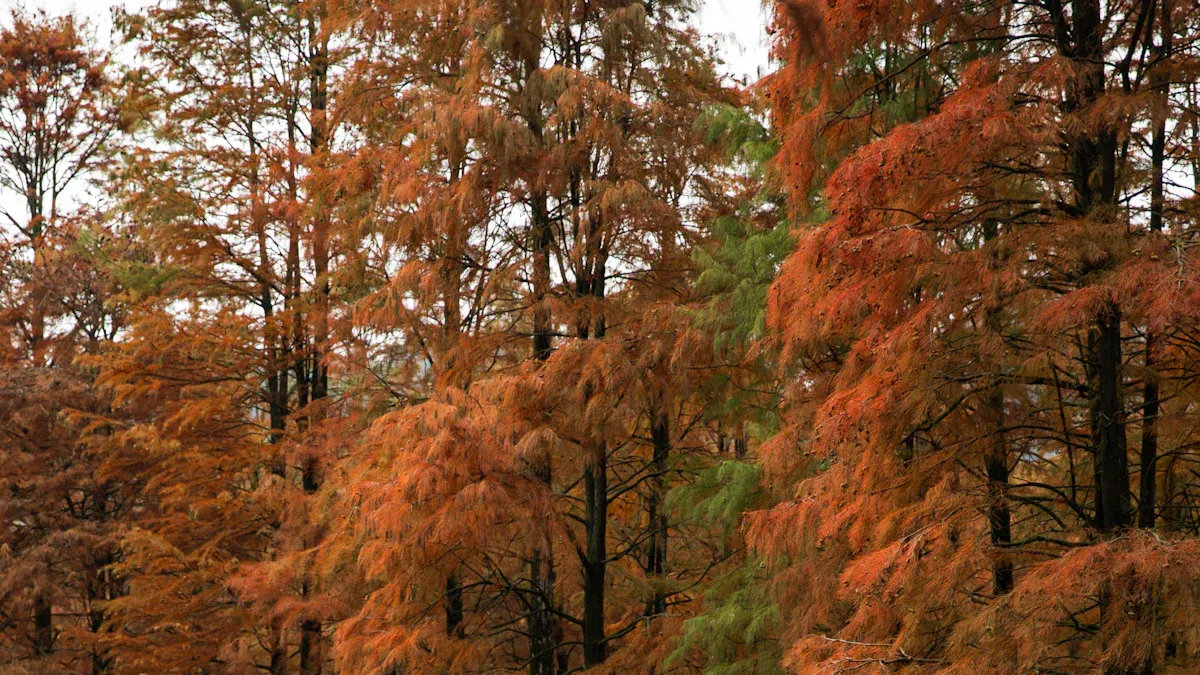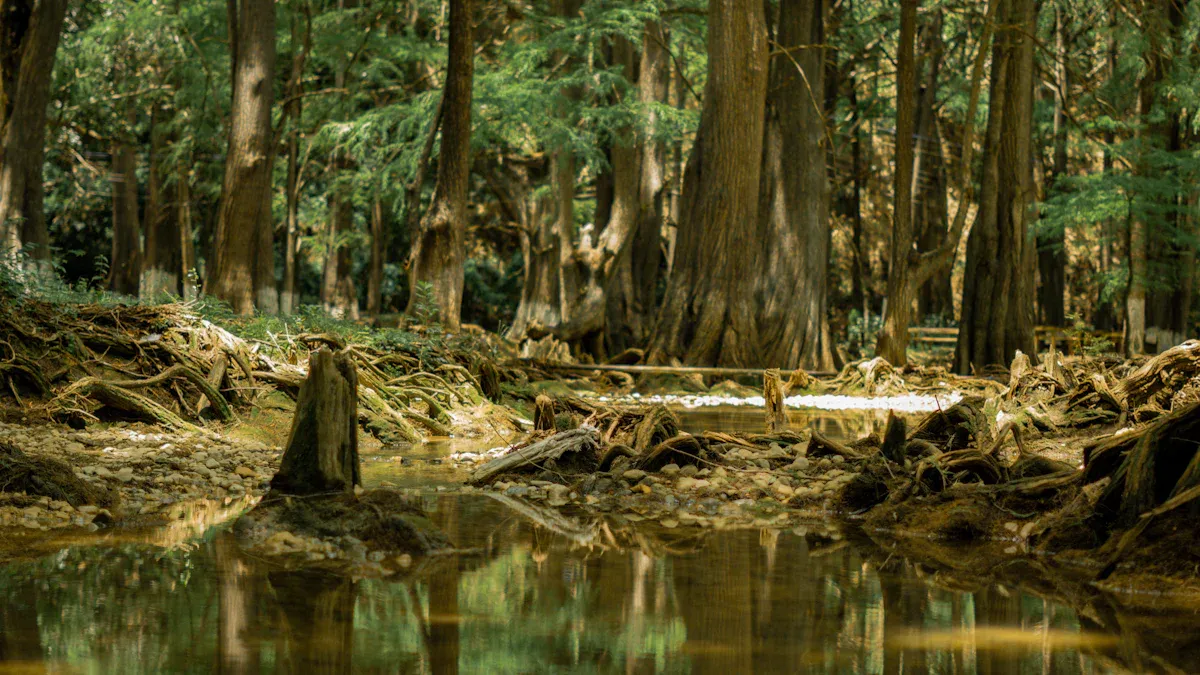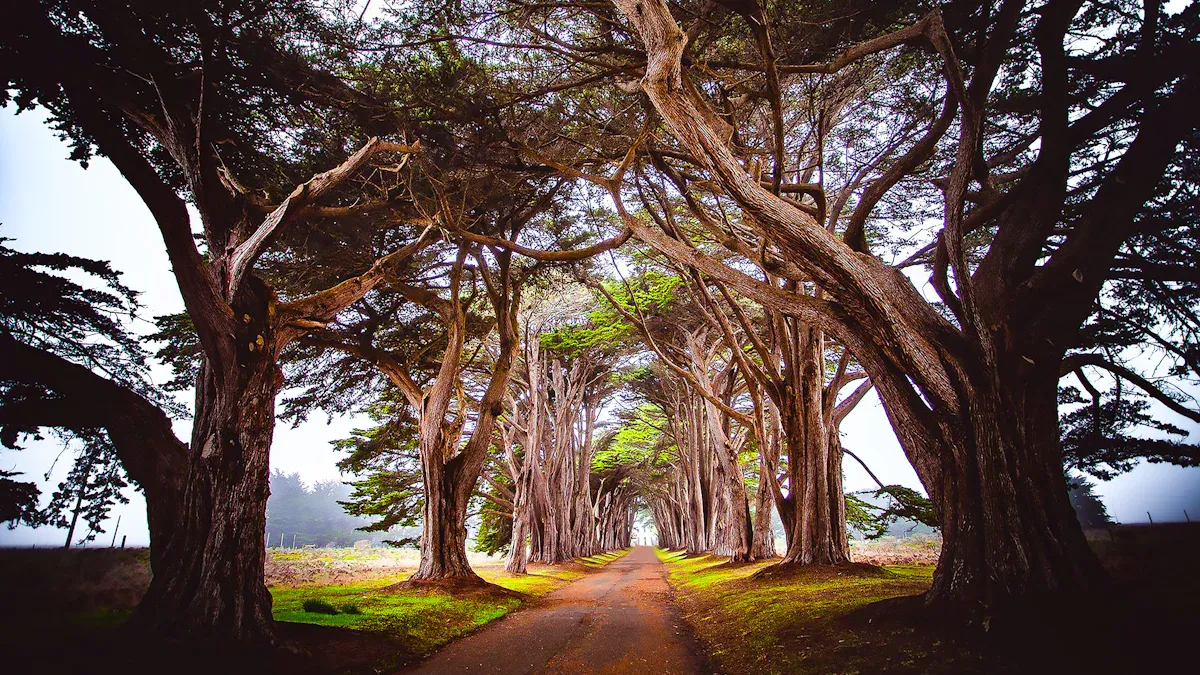
A cypress is a coniferous tree. It often features distinctive foliage and a conical shape. These resilient cypress trees belong to the Cupressaceae family, which encompasses 30 genera and 133 species. Cypress holds significant ecological importance across various climates, stabilizing soil and providing vital habitats for wildlife. The many types of cypress trees show great diversity in their forms, sizes, and adaptations. An ornamental cypress tree can enhance any landscape. This remarkable cypress offers beauty, resilience, and varied uses in landscapes and ecosystems.
Key Takeaways
Cypress trees are a diverse group of trees. They have different shapes, sizes, and ways to live in their environments.
Some cypress trees, like the Bald Cypress, grow in wet places. Others, like the Arizona Cypress, can live in very dry areas.
Cypress trees are useful for many things. People use them for wood, privacy fences, and to help the environment.
Each type of cypress tree has special features. These include how they look, where they grow, and what they are used for.
Bald Cypress

(Taxodium distichum)
Appearance and Size
The bald cypress is a distinctive deciduous conifer. It sheds its needles in the fall, unlike most conifers. This unique characteristic gives the bald cypress its name. A mature bald cypress typically reaches heights of 50 to 70 feet. Some specimens can grow up to 120 feet tall. Its trunk diameter often ranges from 3 to 7 feet. The base of the bald cypress often widens significantly, forming a broad, spreading buttress. This buttressed trunk provides stability. The foliage consists of soft, feathery, light green needles. They turn a beautiful russet color before falling in autumn.
Habitat and Growth
The bald cypress thrives in wetland conditions. It is native to the southeastern United States. This cypress grows well in swamps, riverbanks, and floodplains. The tree adapts to flooded environments. It develops buttressed trunks. These trunks help the bald cypress withstand prolonged periods of standing water. They also provide support against strong winds. The tree also produces “cypress knees.” These woody protrusions emerge from the roots above the water or ground. Scientists believe these knees help with gas exchange or structural support. Planting viable bald cypress seedlings in shallow pits within created wetlands enhances their growth.
Uses and Significance
The timber from the bald cypress is highly valued. It resists rot and insects. People use bald cypress wood for various applications. These include furniture, paneling, and cabinets. Builders use it for siding, decking, and trim. Its durability makes it suitable for outdoor projects. The wood also finds use in boat-building, particularly for planking. Historically, people used bald cypress for piers, bridges, and railroad ties. Pecky cypress, a specialty wood with unique holes caused by a fungus, is popular for paneling. The bald cypress also plays a crucial ecological role. It stabilizes soil and provides habitat for wildlife in wetland ecosystems.
Mediterranean Cypress
Appearance and Size
The Mediterranean cypress (Cupressus sempervirens) stands out with its striking form. This tall tree typically grows 80 to 150 feet in height. It remains very narrow, often only a few feet wide. This gives the Mediterranean cypress a distinctive, column-like shape. It exhibits two main forms. One is a common narrow, upright form, also called ‘fastigiate’. The other form has horizontal branches. The foliage of the Mediterranean cypress is scale-like. It has a very dark green color. This deep green color stays year-round, making it an evergreen.
Habitat and Growth
The Mediterranean cypress thrives in specific environments. It is native to arid regions. You can find it on cliffs and rocky slopes of the East Mediterranean and Middle East. Its native range also includes Iran. This cypress adapts to a range of soil types. However, the soil must be well-drained. It can survive in both acidic and alkaline soils. The Mediterranean cypress also withstands drought conditions well. These adaptations allow it to grow in challenging landscapes.
Uses and Significance
People use the Mediterranean cypress in many ways. They plant it as an ornamental in gardens and cemeteries. This cypress often serves as a centerpiece in formal gardens. Examples include Iran’s oldest extant formal garden, Fin Garden (1590 CE), and others like Dolat-Abad and Shazdeh Garden. Builders also feature it in the tilework of Islamic mosques and administrative buildings. You can see it in the Aqsunqur Mosque in Cairo and Istanbul’s Topkapi Palace. The Mediterranean cypress holds deep cultural meaning. It has religious and spiritual symbolism. It appears as a literary metaphor in works by Virgil, Ferdowsi, and Shakespeare. This cypress also functions as a motif in art across ancient civilizations. These include Elam, Sumer, Egypt, Persia, the Graeco-Roman world, and Islamic Empires. People revere it as an evergreen and long-lived ornamental. It is a sacred tree in Zoroastrianism, especially in Persian culture. Its deep green foliage symbolized death and mourning in Graeco-Roman times.
Leyland Cypress
Appearance and Size
The Leyland cypress (x Cupressocyparis leylandii) is a popular hybrid cypress. It combines features from the Monterey cypress and Nootka cypress. This cypress grows very tall. Mature Leyland cypress trees typically reach heights of 35 to 100 feet. Their spread can range from 8 to 45 feet. It has dense, scale-like foliage. The color is usually dark green or blue-green. Its shape is generally conical or columnar. This gives it a formal appearance in landscapes.
Habitat and Growth
The Leyland cypress adapts well to many environments. It thrives in a wide variety of soil and climate conditions. This cypress grows well in full sun to light shade. It is suitable for hardiness zones 5 to 10. Once established, it tolerates drought very well. Some water during dry periods helps its growth. This resilience makes it a versatile choice for many landscapes.
Uses and Significance
People often use the Leyland cypress for practical purposes. It is a fast-growing evergreen. It can grow up to 3 feet per year. This makes it an excellent choice for creating quick windbreaks. It also provides effective privacy screens. Many people use it in ‘Living Fences’. These natural screens offer privacy, shade, and landscape closure. The dense foliage of this cypress helps reduce energy costs. It blocks wind year-round. These cypress trees offer both beauty and function in many settings.
Arizona Cypress
Appearance and Size
The Arizona cypress (Cupressus arizonica) is a medium-sized evergreen. It typically grows 40 to 60 feet tall. Its trunk can reach 2 feet in diameter. The ‘Carolina Sapphire’ cultivar of Arizona cypress has outer red-brown bark. This bark sheds each year. It reveals a bright red, smooth inner bark. As the Arizona cypress ages, its bark exfoliates. This creates a mottled look with patches of burnt orange and green. The foliage is generally blue or blue-green. Some forms have gray-green, blue, or yellow leaves. The ‘Cookes Peak’ cultivar shows silvery-blue foliage. This cypress has a conical shape.
Habitat and Growth
This cypress thrives in hot and dry conditions. It grows well in dry, well-drained soils. The Arizona cypress is a drought-tolerant species. It can live in very dry places. These include south-facing slopes, ridge tops, and convex slopes at higher elevations. It also grows in areas with long summer droughts. This cypress is native to the southwestern United States and Northern Mexico. You can find it in mountain canyons. It grows at elevations from 3,000 to 8,000 feet. It prefers gravelly slopes or cuts with northern exposure. This cypress often forms pure, dense groves on canyon side slopes. It also associates with chaparral habitats. The Arizona cypress-shrub live oak association grows on wet, north slopes. These slopes typically have soils from slate, schist, limestone, and granite.
Uses and Significance
People use this cypress in many ways. It serves as an ornamental planting in gardens. Its dense foliage makes it excellent for windbreaks. Many people choose it as a Christmas tree. It also helps with reforestation efforts. This cypress stabilizes soil in arid areas. It is a good choice for xeriscaping, which uses less water. These cypress trees provide habitat for birds. They also offer shelter for small mammals. The resilience of this cypress makes it valuable for both landscaping and ecological purposes.
Monterey Cypress

Appearance and Size
The Monterey cypress (Cupressus macrocarpa) is a striking evergreen. It typically grows 40 to 70 feet tall. Its trunk can reach a diameter of 2 to 4 feet. This cypress often develops a characteristic gnarled trunk. It also has a windswept canopy shape. Constant onshore winds and coastal conditions primarily shape this unique form. These winds bend the tree’s leaders. They also shorten its windward twigs. This results in a flat, ‘flagged’ crown. Cool fog, ocean winds, and salt spray prune and sculpt the canopy. This creates its famous windswept appearance. Cypress trees grown in sheltered inland sites develop a more upright and regular form. This shows the important role of coastal exposure in shaping the gnarled and windswept characteristics.
Habitat and Growth
The Monterey cypress thrives near the sea. It is native to the Monterey Bay, California, area. This cypress possesses a high tolerance for wind. Wind actually enhances its aesthetic appeal under heavy conditions. It thrives in foggy coastal areas. Strong ocean winds and salty sea spray make it difficult for other tree species to survive there. The wind exposure sculpts its unique and picturesque growth habit. This is similar to trees found in alpine timberlines. This cypress exhibits high tolerance to wind and aerosol salt. This makes it an ideal coastal tree. In its natural habitat, these cypress trees flourish in cool summers. Sea fog consistently bathes these areas. The Monterey cypress is highly resistant to drought and salt spray. This makes it an excellent choice for coastal landscapes and dry conditions.
Uses and Significance
The Monterey cypress is rare in its native range. Housing developments and golf courses have destroyed significant portions of its groves on the Monterey Peninsula. The species faces various threats. Grazing and trampling by livestock harm seedlings. It is susceptible to damping-off fungi. It is also highly vulnerable to coryneum canker. This disease can kill trees. It has eliminated some inland plantations. Insect infestations, such as bark beetles, can damage seeds and trees. While native to the Monterey coast, this cypress is considered moderately invasive in other parts of California. It spreads from planted windbreaks or hedgerows. However, the native trees of the Monterey Peninsula, including Monterey cypress, are crucial for local biodiversity. They support wildlife, improve air quality, and contribute to carbon sequestration.
Hinoki Cypress
Appearance and Size
The Hinoki cypress (Chamaecyparis obtusa) is a graceful evergreen. It typically grows 50 to 75 feet tall. Some can reach over 100 feet. Its trunk can grow 3 to 5 feet in diameter. The bark is reddish-brown. It is fibrous and fissured into thin strips. This gives the trunk a textured look. The leaves are scale-like. They are densely imbricate, meaning they overlap tightly. They appear closely appressed to the stems. The upper surface of the leaves is dark green. The underside has distinctive white marks. These marks often form ‘X’ or ‘Y’ shapes. The leaf tips are blunt. They often have a keel, or ridge.
Habitat and Growth
The Hinoki cypress thrives in specific environments. It is native to southern Japan. This cypress prefers moist, well-drained soil. The soil should also be porous. It grows best in neutral to slightly acidic soil. A pH range of 5.0 to 6.0 is ideal. It shows a preference for more acidic soil. This cypress grows well in temperate climates. It needs consistent moisture but dislikes soggy conditions. Proper drainage is key for its root health.
Uses and Significance
People highly value Hinoki cypress wood. It has a pleasant smell and resists humidity. These qualities make it suitable for peaceful places. Builders use it for baths and meditation rooms. Its strength and natural antibacterial properties make it useful. Japanese restaurants use it for countertops and plates. Historically, people used Hinoki cypress wood for important structures. They built temples, palaces, and shrines with it. They also constructed noh theatres. Craftspeople made masu, which are wooden sake cups, from this cypress. The wood’s durability and beauty make it a cherished material in Japanese culture. This cypress is also a popular ornamental tree in gardens worldwide.
Nootka Cypress
Appearance and Size
The Nootka cypress (Callitropsis nootkatensis) is a majestic evergreen. It typically grows 60 to 90 feet tall. Some Nootka cypress trees can reach over 120 feet. Its trunk can grow 2 to 4 feet in diameter. This cypress has graceful pendulous branches. These branches upsweep at the ends. The foliage consists of flattened sprays. These sprays are gray-green or blue-green. The branches are long and pendulous. They are clothed with dark bluish-green or grayish-green, scale-like ‘needles’. This conical tree has drooping branches. Its vertical, flattened sprays of bluish green to dark green foliage are distinctive. The branches curve upward with drooping branchlets.
Habitat and Growth
The Nootka cypress thrives in specific environments. It is native to the Pacific Northwest. You can find it in coastal rainforests. It also grows on rocky ridgetops near the timberline in the mountains. In Northern British Columbia and Alaska, it often grows at sea level. It is found in wet, boggy forests there. This cypress grows in wet to moist sites. It tolerates cool and wet conditions. In the southern parts of its range, it rarely grows below 2,000 feet in elevation. North of midcoastal British Columbia, it can be found from sea level to the tree line. This cypress is notable for its tolerance of cool and wet conditions.
Uses and Significance
Nootka cypress wood is highly valued. It is also known as Alaska Yellow Cedar. This wood naturally resists rot and decay. Its dense and strong nature comes from tight growth rings. This makes it an ideal choice for roofing and siding applications. It is a sought-after specialty building material. Both residential and commercial projects use it. It performs well for years with little maintenance. This cypress wood is used for decking, trim, cabinets, and flooring. Other applications include exterior siding, shingles, cladding, and outdoor furniture. People also use it for boardwalks, boat building, and marine applications. It is one of the most decay-resistant woods among Pacific Northwest cypress trees. Its lumber is highly valued for outdoor construction. This includes ground-contact uses like fence posts and garden beds.
Pond Cypress
Appearance and Size
The pond cypress (Taxodium ascendens) is a unique deciduous conifer. It typically grows 30 to 60 feet tall. Its spread ranges from 15 to 30 feet. This makes it smaller than its relative, the bald cypress. The pond cypress has a slender, columnar, and upright growth habit. Its branches ascend more vertically. The foliage of the pond cypress is distinctive. Its leaves are needle-like and appressed, meaning they press closely to the branches. The variety name ‘imbricarium’ refers to their overlapping manner. These leaves also tend to point or grow upward in an arching or curving fashion. In contrast, bald cypress foliage looks more like a feather with leaflets branching off to the left and right.
Habitat and Growth
The pond cypress thrives in specific wetland environments. It grows well in shallow ponds and lake margins. You can find this cypress in swamps and wetlands. It also grows along the banks of ponds and lakes where water is stagnant. This cypress often inhabits southern swamps, bayous, and rivers. It thrives in isolated depressions fed by nutrient-poor, shallow groundwater. The pond cypress also grows in low slash pine savannas where thin sandy soil periodically dries. It is common in isolated wetland depressions like Carolina bays in the Atlantic Coastal Plain. In the Gulf Coastal Plain, it grows in limesinks, cypress domes, or cypress ponds. These depressions are typically rainfall-fed. They can be permanently flooded or hold water well into the growing season. Water levels in these areas vary over time.
Uses and Significance
The pond cypress plays a crucial role in wetland ecosystems. It offers vital habitat and food sources for various wildlife. This helps foster a flourishing ecosystem. Its root system is instrumental in preventing soil erosion in wetland environments. This helps stabilize landscapes and protect waterways. The plant’s ability to withstand flooding and wet soil conditions makes it an excellent choice for areas prone to water accumulation. Other plant species might struggle in such conditions. When people integrate this cypress into garden designs, especially with companion planting, it contributes to a vibrant ecosystem. This attracts wildlife and boosts biodiversity. These cypress trees are valuable for both their ecological benefits and their unique appearance.
This exploration of eight types of cypress trees reveals their remarkable diversity. From the water-loving Bald Cypress to the drought-resistant Arizona cypress, each cypress offers unique features. These versatile cypress trees serve many purposes. They provide privacy screens, valuable timber, and ecological benefits like wetland restoration. When selecting a cypress for your environment, consider its specific size, climate needs, and soil preferences. These magnificent cypress trees contribute enduring beauty and resilience to diverse landscapes.
FAQ
What is a cypress tree?
A cypress tree is a coniferous tree. It belongs to the Cupressaceae family. These trees often have distinctive foliage and a conical shape. Many cypress types are evergreens, but some, like the Bald Cypress, shed their needles in autumn.
What are cypress knees?
Cypress knees are woody growths. They emerge from the roots of Bald Cypress trees. These protrusions grow above the water or ground. Scientists believe knees help the tree with gas exchange or provide extra structural support in wet environments.
What makes cypress wood durable?
Cypress wood is very durable. It naturally resists rot and insects. This resistance comes from natural oils within the wood. These qualities make cypress wood excellent for outdoor construction, furniture, and boat building.
What is the difference between Bald Cypress and Pond Cypress?
Bald Cypress (Taxodium distichum) grows larger and has feathery foliage. Pond Cypress (Taxodium ascendens) is smaller with a more slender, columnar shape. Its leaves are needle-like and press closely to the branches, pointing upward.

